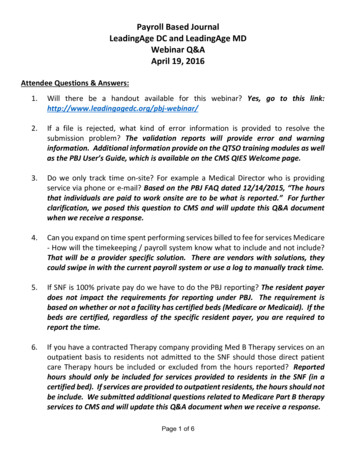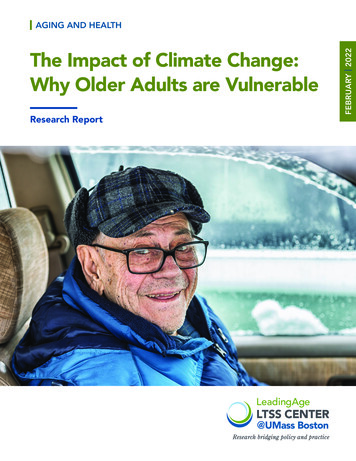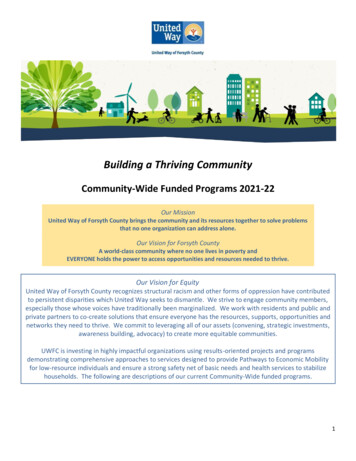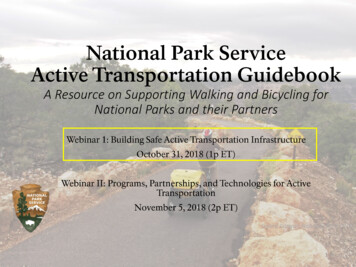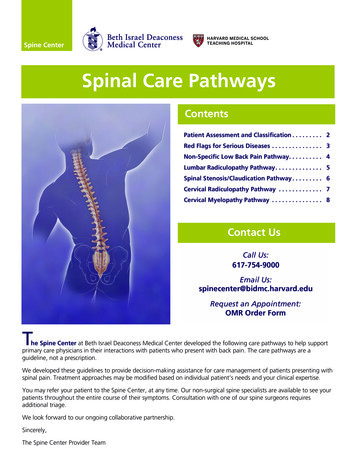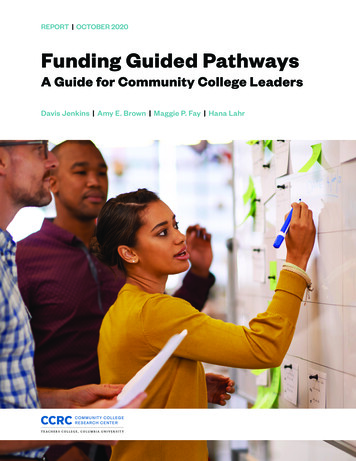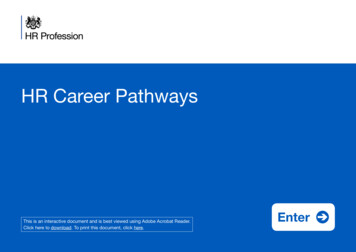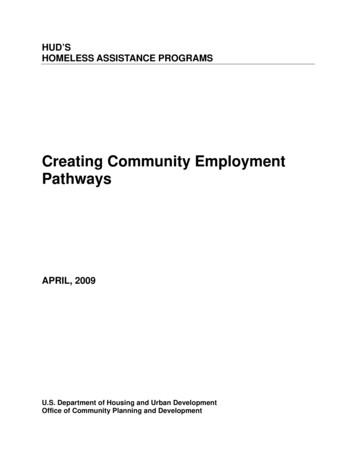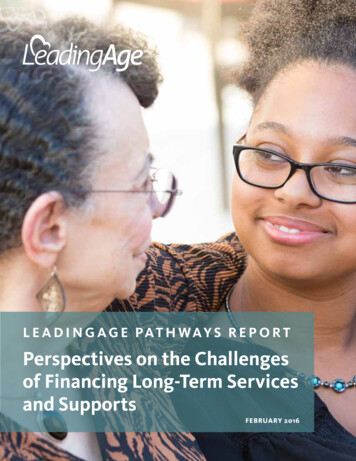
Transcription
L E A D I N G A G E PA T H W A Y S R E P O R TPerspectives on the Challengesof Financing Long-Term Servicesand SupportsFEBRUARY 2016
We have historically embraced some of the mostintractable challenges in our communities and foundabiding solutions. As the ground shifts beneath us, wemust again come together and put this same wisdomto work.—KATHRYN ROBERTS, CHAIRLeadingAge Board of Directors
EXECUTIVE SUMMARYRecent research conducted by Urban Institute andMilliman, Inc. on behalf of LeadingAge, The SCANFoundation, and AARP shows definitively that the nation’scurrent methods for financing long-term services andsupports (LTSS) are unsustainable, irrational, and unfairfor individuals and families.to increase over the next decades. Therefore, it is essentialthat we find ways to:LeadingAge believes America needs a fairer and more rational financing system to ensure access to quality LTSS. Basedon research, discussions, and modeling work conducted overthe last 12 years, we know that workable solutions can bedeveloped to reach this goal.LeadingAge is seeking a different future for a variety ofstakeholders – including older adults, younger people withdisabilities, families, paid and unpaid caregivers, employers,middle-income individuals, LTSS providers, federal and stategovernments, and taxpayers.We believe that a new system of financing LTSS needs to beinsurance-based and guided by the principles of rationality,equity, and affordability.1. There is new evidence that the current LTSS financingsystem is untenable.2. A universal insurance approach that covers catastrophiccosts would have the greatest positive impact on bothindividuals and strained public programs, while creatinga more rational system.WHY NOW?Three pressing challenges are driving our efforts to reformthe financing system for LTSS.The status quo is unsustainable. There is no doubt thatLTSS costs will continue to rise and spending will continuenHelp Americans plan for and meet their LTSS needs.nHonor the critical role of families without cripplingthem financially.nReduce reliance on Medicaid.The existing system for LTSS financing is irrational. Personal savings and Medicaid will continue to be the de factosources of LTSS financing, due to limited LTSS coverage under Medicare and the fact that the private insurance marketoffers few affordable options to pay for LTSS. Consider this:nPrivate, long-term care insurance currently covers lessthan 10% of LTSS expenditures.nMedicare benefits are largely limited to coverage of postacute care (services received after hospitalization).The LTSS financing system is unfair. We can no longertolerate an approach that grants access to LTSS only tothose with high levels of wealth or low levels of income andwealth. Consider this:nWealthy individuals have the ability to plan for theircare needs and to pay for that care privately or by purchasing private insurance.nIndividuals living in poverty can access their state’sMedicaid programs to meet LTSS needs.nMiddle-income consumers, on the other hand, are leftwith few options other than depleting their savings, relying heavily on unpaid family caregivers, or living withunmet needs.LeadingAge Pathways Report: Perspectives on the Challenges of Financing Long-Term Services and Supports 1
HOW SHOULD WE EVALUATETHE PROPOSED SOLUTIONS?Ultimately, the solutions we adopt to address the challengeslisted above should provide reasonable protections to allowany individual who requires LTSS to live with dignity andindependence. While we recognize that the need for LTSS isnot limited to older people, in this report we have limited ourfocus to the 65 and older population modeled by the UrbanInstitute and Milliman, Inc.Several important assumptions will shape our understanding of these proposed solutions:nThe need for LTSS is a risk, not a certainty, for any oneperson. However, for those needing LTSS, the costs farexceed an individual’s ability to pay.nWidespread participation is essential. Insurance products that spread risk broadly generally require higherlevels of participation to optimize coverage and costs.nAffordability and value should be key characteristics ofany insurance product that is designed to protect againstLTSS risk. Consumers will not be interested unless theybelieve that its costs can be incorporated into their budgets and that its coverage represents a value, compared toother household priorities.2 LeadingAge Pathways Report: Perspectives on the Challenges of Financing Long-Term Services and Supports
INTRODUCTIONEach and every day, LeadingAge members witness the devastating effects that our nation’s dysfunctional LTSS financingsystem has on older adults and their families.These not-for-profit and mission-driven organizations havetaken the lead in creating and delivering the most innovative,forward-thinking, and high-quality services currently available in the home and in community settings. Yet, despitetheir innovation, creativity, and commitment to service,these LeadingAge members face real and serious limitations:nThey do not have the resources to help every familycaregiver who is exhausted or struggling to keep up withoften overwhelming responsibilities.nThey cannot provide the funds or services necessary tohelp every older adult in need.These are real problems that we hear from our membersevery day.PREDICTING THE LTSS FINANCING CRISISLeadingAge is committed to creating a better experience forpeople as they age. We have long recognized that the nation’smethods of financing LTSS are inadequate.In 2004, we convened a Finance Cabinet comprised of leaders from LeadingAge member services organizations. TheCabinet conducted an in-depth examination of then-currentapproaches to long-term care financing. Based on that study,it predicted an impending crisis in the financing and deliveryof LTSS, as a result of expected increases in the number ofpeople living to old age who would need assistance.The Finance Cabinet concluded that:nThe LTSS financing crisis arose from the fact that thecurrent primary methods of paying for services – theMedicaid program and private pay – are not sustainable.nThe need for services was a risk, not a certainty. Therefore, LeadingAge should consider the role of both publicand private insurance when exploring ways to avoid thecoming LTSS financing crisis.During the next six years, LeadingAge worked in concertwith other advocacy and consumer organizations representing older adults and younger people with disabilitiesto advocate for CLASS, a voluntary, federally administered,consumer financed insurance plan that would have provided participants with cash to help pay for needed assistance.CLASS was included in the Affordable Care Act, but wasrepealed in 2012.The LTSS financing problem remains unsolved. Yet, severalkey principles, which LeadingAge adopted in 2006, remainrelevant today. These principles suggest that, no matter whatLTSS insurance model is developed, that model:1. Must be self-sustaining and, if possible, relieve a strainedMedicaid program.2. Must be affordable, easy to obtain, and available to all,regardless of pre-existing conditions.3. Is likely to incorporate the characteristics of a universal,public approach.LeadingAge Pathways Report: Perspectives on the Challenges of Financing Long-Term Services and Supports 3
LEADINGAGE PATHWAYS: ANALYZINGLTSS FINANCING PROPOSALSIn 2012, LeadingAge convened a task force to bring newthinking to the question of how to pay for LTSS. Membersof the Pathways Task Force included a wide range of policyexperts from across the political spectrum, as well as insurers, consumers, and LeadingAge members.The Pathways Task Force identified seven different pathways—or options—to financing LTSS.The first Pathways report, issued in 2013, led to a subsequenteffort to develop actuarial and economic analyses of LTSSfinancing proposals. LeadingAge, AARP, and The ScanFoundation contracted with Urban Institute and Milliman,Inc., to model the impact of different LTSS financingdesigns.The modeling initiative concluded in late 2015. This report,Perspectives on the Challenges of Financing LTSS, representsLeadingAge’s conclusions and vision moving forward.The momentum created through the LeadingAge Pathwaysinitiative must continue. Otherwise, we will lose valuableground that older Americans and their families can’t affordto lose.We must continue to chip away at the challenge of LTSSfinancing. We must regularly reflect on the progress we aremaking. We must pay attention to the lessons we are learning along the way. And we must continue to build on thoselessons until permanent solutions are within our grasp.4 LeadingAge Pathways Report: Perspectives on the Challenges of Financing Long-Term Services and Supports
THE CHALLENGEThere is no one-size-fits-all answer to solving the problem ofLTSS financing. Many factors contribute to the complexity ofthe problem, including issues related to unpaid caregiving;the growing need for LTSS, especially among women; theburden of out-of-pocket expenses; the impact of skyrocketing costs on Medicaid; the danger of unmet needs; and theneed for public education about LTSS.CAREGIVINGUnpaid caregiving is integral to the way the nation delivers LTSS. Caregiving is woven into the fabric of our lives,whether we are caring for young children, a spouse with adisability, or our aging parents. Caregiving, after all, is whatfamilies do.Unfortunately, the caregiving role does not come withoutemotional, physical, and financial stresses. In 2015, onein five caregivers reported a high level of physical strainas a result of caregiving. Four in 10 caregivers consideredcaregiving to be highly stressful emotionally.1Caregiving costs are difficult to estimate or measure becauseso much care is provided behind the scenes. Caregivers operate as invisible payers as they fulfill the personal responsibility they feel to care for a loved one.An estimated 17% of working adults care for a family member or friend and provide unpaid care valued at 470 billionannually.21 AARP Public Policy Institute, & National Alliance forCaregiving. (2015, June). Caregiving in the U.S. Washington, DC:Author.Reinhard, S. C., Feinberg, L. F., Choula, R., & Houser, A. (2015,July). Valuing the invaluable: 2015 update. Washington, DC:AARP Public Policy Institute.2An estimated 17% ofworking adults carefor a family member orfriend and provideunpaid care valued at 470 billion annually.Families continue to do all they can. Often, however, theirresources are stretched to the breaking point. Caregivingcan negatively affect the health and financial well-being ofcaregivers. It can also impact their productivity at work. A2012 MetLife Market Survey estimated that caregiving coststhe nation 34 billion in annual lost productivity.3As the population of aging Americans continues to grow,more people will be called on to provide unpaid care. Thissituation promises to put a strain on our workforce and thelivelihood of our citizens.3The MetLife Mature Market Institute. (2012, November). Marketsurvey of long-term care costs: The 2012 MetLife market survey ofnursing home, assisted living, adult day services, and home carecosts. New York, NY: Author. term-care-costs.pdf.LeadingAge Pathways Report: Perspectives on the Challenges of Financing Long-Term Services and Supports 5
In 2010, there were 7.2potential caregiversavailable for everyperson in need. In 2050,that number will dropto 2.9.Approximately seven in 10 Americans who reach age 65 inthe next five years can expect to need some level of LTSS.Almost a fifth (19%) of Americans over age 65 are expectedto have LTSS needs that last less than a year, and about 14%are expected to have needs that last more than five years.6Expenses associated with LTSS will double as a share of theeconomy over the next 30 years.7 Unless we find alternativeapproaches to LTSS financing, our ability to provide and payfor care for future generations of older Americans will beseriously impacted. Older adults themselves will not be prepared for the costs they might incur to use LTSS. In addition,our greatest source of care -- unpaid care from family andfriends -- will become less available due to the dwindlingsupply of potential caregivers.6To further compound the caregiving crisis, the number ofcaregivers is diminishing. In 2010, there were 7.2 potentialcaregivers available for every person in need. In 2050, thatnumber will drop to 2.9.4LTSS NEEDSThe risk of needing LTSS grows with age. By 2055, there willbe almost 90 million people aged 65 and over. Half of theseolder Americans will be over age 75.5 The number of peopleage 85 and older will more than double by 2055.7Congressional Budget Office. (2013). Rising demand for longterm services and supports for elderly people. Washington, DC:Author.Projected number of people age 65or older by year2015In some cases, caregivers are forced to reduce hours at workor quit their jobs to provide care at home. Many of thesecaregivers will experience a decrease in overall earningsthat may affect their Social Security income and retirementsavings. Women, who provide 60% of unpaid caregiving, areat an even greater risk than men.Favreault, M. M., & Dey, J. (2015). Long-term services andsupports for older Americans: Risks and financing research brief.Washington, DC: Department of Health and Human Services,Office of the Assistant Secretary for Planning and Evaluation.50 millionRedfoot, D., Feinberg, L., & Houser, A. (2013, August). TheAging of the Baby Boom and the Growing Care Gap: A Lookat Future Declines in the Availability of Family Caregivers.Washington, DC: AARP Public Policy Institute.2055490 million5Favreault M. M,, & Johnson, R. W. (2015). Projections oflifetime risk of long-term services and supports at ages 65 andolder under current law from DYNASIM. Washington, DC: UrbanInstitute.6 n Age 65–74n Age 75–84n Age 85
Those at greatest risk of experiencingLong-Duration (5 years) High Level of NeedWomen82%higherchancethan 87%higherchance gherchance thanthose withexcellenthealthFair orPoorHealthWOMEN AND LTSSOUT-OF-POCKET EXPENSESUnfortunately, financial circumstances don’t always alignwith the cost of LTSS. In 2014, individuals aged 65 and overhad median financial assets of 75,750 and median homeequity of 80,600.9 This level of resources is not sufficientto cover the costs of retirement, let alone additional LTSSexpenses.In many cases, individuals or family members pay for a lovedone’s services because the care recipient can no longer affordto pay for that care, especially when the level of needed careis high. However, middle- and low-income families rarely areprepared for the financial impact of paying for LTSS.Families often resort to depleting savings and other retirement funds to pay for the care on which a loved onedepends. These families turn to Medicaid when they run outof money. Otherwise, the person in need goes without care.Women are disproportionately affected by LTSS in two ways:IMPACT ON MEDICAID1. Women are more likely to need LTSS services. Almost60% of women who reach age 65 in the next five yearswill experience LTSS needs, compared with 47% of men.Thus, women have a 23% greater risk of needing LTSSthan men.The Medicaid program was created as a safety net healthcare program for the poor. However, Medicaid has becomethe default payer for LTSS because there are no significantalternative sources of payment for LTSS, other than privatepay. With no other viable third-party funding option formiddle-income individuals and families, the fiscal burdenfor LTSS falls directly on the Medicaid program for thesubset of individuals who live with high levels of need for anextended period of time.In addition, women will need services and supports for longer durations – five years or more. Others who are at greatestrisk of experiencing LTSS for five or more years includeunmarried individuals, those in the lowest income brackets,and those who rate themselves in poor or fair health.82. Women are more likely to be the primary, unpaid caregiver for a relative or friend. Women who outlive theirspouses will face additional challenges, including theloss of caregiving support, isolation, and a decrease inearnings.8Favreault, M. M., & Johnson, R. W. (2015). Projections oflifetime risk of long-term services and supports at ages 65 andolder under current law from DYNASIM. Washington, DC: UrbanInstitute.As of 2013, over one-third of all Medicaid expenditureswent towards paying for LTSS.10 LTSS spending in the U.S. isprojected to grow more than 10-fold over the next 50 years,from approximately 200 billion today to over 3 trillion by2070. Medicaid expenditures on LTSS for older adults willincrease similarly and will exceed 1 trillion by 2070.11This growth will be difficult to support at the state or federallevel and will increase pressure on state and federal budgets.9Jacobson, G., Swoope, C., Neuman, T., & Smith, K. (2015,September). Income and assets of Medicare beneficiaries, 20142030. Menlo Park, CA: Henry J. Kaiser Family Foundation.10Eiken, S., Sredl, K., Burwell, B., & Saucier, P. (2015, June 30).Medicaid expenditures for long-term services and supports in FY2013: Home and community-based services were a majority ofLTSS spending. Ann Arbor, MI: Truven Health Analytics.11Favreault, M., & Johnson, R. (2015, November).Microsimulation analysis of financing options for long-termservices and supports. Washington, DC: Urban Institute.LeadingAge Pathways Report: Perspectives on the Challenges of Financing Long-Term Services and Supports 7
At the state level, where deficit spending is not allowed, Medicaid spending is already competing with and beginning todominate other state spending priorities. For the last threeyears, Medicaid spending was the single largest componentof state spending nationwide, representing 27% of state budgets in fiscal year 2015, up from 24% in 2008.12 This trendwill only get worse for states as the population needing LTSSgrows dramatically.UNMET NEEDIndividuals and families often are unable to deliver the carethat their family members need. Critical needs could gounmet if these individuals and families:nCannot afford to purchase necessary services from outside providers.nDo not recognize that additional services may be needed.nAre faced with mounting bills.nHave incomes that are too high to qualify for Medicaidbut not high enough to afford care.Unmet needs create unsafe conditions for older adults, andoften result in adverse consequences. Failure to meet theneed for LTSS can be detrimental to a person’s health andwell-being. It can also increase costs for Medicare when lackof access to LTSS leads to increased hospitalizations andother acute care needs.13PUBLIC EDUCATIONResearch indicates that most Americans do not recognize thepossibility that they will need LTSS, and do not understandhow much those services will cost. Many Americans mistakenly believe that Medicare covers the cost of LTSS. This lackof understanding makes it difficult to spur Americans to planahead for LTSS needs, or to mobilize this population aroundefforts to design a more rational LTSS financing system.12National Association of State Budget Officers. (2015). Stateexpenditures report: Examining fiscal 2013-2015 state spending.Washington, DC: Author.13Komisar, H. L., & Feder, J. (2011). Transforming care forMedicare beneficiaries with chronic conditions and long-termcare needs: Coordinating care across all services. Washington,DC: Georgetown University. Available from: es/Georgetown TrnsfrmingCare.pdf.8 LeadingAge Pathways Report: Perspectives on the Challenges of Financing Long-Term Services and Supports
THE PATHWAYS APPROACHIn 2013, LeadingAge proposed that a productive nationalconversation about LTSS financing would require a framework for thinking about and discussing challenges andpotential solutions. The Pathways Task Force developed asolutions framework that delineated seven pathways representing a spectrum of financing options, from those highlyreliant on private markets to those highly reliant on publicprograms. Those seven pathways include the following:1. Status Quo: Acknowledges that the current LTSS financing system relies on people being personally responsiblefor meeting their LTSS needs if they are not eligible forpublic programs. This pathway also recognizes that public programs cover 72% of all LTSS expenditures.142. Personal Responsibility: Tightens the public safety netand narrows eligibility for public programs. The intention of this pathway is to reduce the government’s role infinancing LTSS by fostering more personal responsibilityin planning for and meeting individual needs.3. Private Market: Activates and strengthens the privatemarket as the primary source of meeting the LTSS needsof Americans.4. Private Catastrophic: Requires that individuals purchasecatastrophic long-term care insurance in the privatemarket.6. Common Good: Creates a public program to meet basic“front-end” LTSS needs that appear relatively early inthe period of disability. Working and retired Americansreceive cash and/or services for a defined dollar amountor time limit.7. Comprehensive: Combines public catastrophic coverageand front-end common good coverage to create a comprehensive program that provides a benefit of cash and/or services to meet LTSS needs.The Pathways approach to framing the issue of LTSS financing was based on two central beliefs:nThe need for LTSS is a risk, not a certainty, for any oneperson.nHowever, for those needing LTSS, the costs far exceedan individual’s ability to pay. Clearly, these costs can becatastrophic for the unlucky.Any LTSS insurance product aligned with these beliefsmust spread risk broadly so that LTSS can be available andaffordable for all. Private and public insurance products haveimportant complementary roles to play in offering meaningful alternatives to Medicaid that are widely affordable andaccessible, and preserve and strengthen essential safety nets.5. Public Catastrophic: Requires that individuals purchasecatastrophic long-term care insurance through a publicprogram by paying premiums to the government.Reaves, E. L., & Musumeci, M. (2015, December). Medicaidand long-term services and supports: A primer. Washington, DC:Kaiser Family Foundation.14LeadingAge Pathways Report: Perspectives on the Challenges of Financing Long-Term Services and Supports 9
BRINGING RESEARCH TO THE PATHWAYSLeadingAge, The SCAN Foundation, and AARP jointly funded economic and actuarial analyses to better understand theeffects of several alternative approaches that begin to addressthe LTSS financing issue.We applaud the technical work that was completed by UrbanInstitute15 and Milliman, Inc.16 to provide the first significantmodeling of policy options to address the issue of financingLTSS in over 10 years.TESTING THREE APPROACHESThree new insurance approaches were tested through microsimulation modeling that allows for a longitudinal studyof projected effects. Results of the analyses estimate thepotential impact of each of the following three approacheson private out-of-pocket spending and the LTSS spending ofother payers:nA front-end-only benefit that provides coverage relatively early in the period of disability, but caps benefits.nA back-end benefit with no lifetime limit.nA combined comprehensive benefit.15Favreault, M. M. & Johnson, R. W. (2015, November).Microsimulation analysis of financing options for long-termservices and supports. Washington, DC: Urban Institute. /files/urbaninstitute microsimulation analysis of ltss nov. 2015.pdfThe modeling work looked at outcomes resulting from variations in different insurance program designs. Implicationsfrom the modeling findings can be applied to the initialseven pathways first described in LeadingAge’s 2013 report.17While the model’s scenarios do not match any specific pathway, with the exception of the status quo, valuable insightson the potential effects of each pathway can be drawn fromthe research. For example:Status Quo. The modeling results provide strong evidencefor the unsustainability of the status quo, given projectedincreases in LTSS needs, the shrinking availability of familycaregivers, and anticipated growth of LTSS expenditures instate and federal government budgets. Across dimensions ofcoverage and cost, this approach does not compare favorably to other pathways. In addition, the current system doesnot function well for those with access to public or privatecoverage.Personal Responsibility. Out-of-pocket costs and unmetneed would increase under this pathway, due to tighteningof Medicaid eligibility standards. Middle-income individualswould be left without viable financing options unless changes were made in the private long-term care insurance marketor other savings vehicles.Private Market. Modeling suggests that a reformed privatemarket, which offers new and innovative ways to pay forLTSS, could create greater demand and expanded coverageof individuals who are at risk for needing LTSS. This wouldbe especially true for designs that limit coverage to front-end16Giese, C. J. & Schmitz, A. J. (2015, November 17). Premiumestimates for policy options to finance long-term services andsupports. Brookfield, WI: Milliman, Inc. See: es/milliman report -premium estimates for policy options to finance ltss.pdf17LeadingAge Finance Task Force. (2013, October). LeadingAgePathways: A framework for addressing Americans’ financial riskfor long-term services and supports. (Final Report, Phase 1).Washington, DC. See: http://www.leadingage.org/pathways/10 LeadingAge Pathways Report: Perspectives on the Challenges of Financing Long-Term Services and Supports
needs. The private market would not be sufficient by itself toaddress all issues related to LTSS financing. However, changes to various aspects of private long-term care insurancehave the potential to substantially reduce private marketpremiums.18The modeling did not estimate that large increases in longterm care insurance participation would result from privatemarket reform ideas. However, LeadingAge believes thatinnovative marketing and distribution strategies deservefurther development because they could have a significantimpact on the willingness of consumers to purchase insurance.Private or Public Catastrophic. The modeling did not compare private and public options for catastrophic coverage.However, the results show broadly that this pathway offersthe strongest option for offsetting Medicaid spending whenenrollment is required. This pathway could also relieve individuals of their out-of-pocket costs, albeit in a limited way,18Giese, C.J. & Schmitz, A.J. (2015, November 17). Premiumestimates for policy options to finance long-term services andsupports. Brookfield, WI: Milliman, Inc. See: es/milliman report -premium estimates for policy options to finance ltss.pdfsince out-of-pocket costs tend to be incurred in earlier yearsof need. As modeled, catastrophic benefits would not beginfor two years after the onset of eligible LTSS needs.Common Good. This pathway, referred to in the modelingas front-end benefits, could potentially offset individual outof-pocket costs, according to the modeling results. Howeverthe impact of this pathway will be significantly affected bywhether purchase of the coverage is voluntary or mandatory.Comprehensive. Modeling suggests that this pathway haspotential to concurrently offset both Medicaid and out-ofpocket costs. However, the comprehensive pathway is themost costly of all the new designs that were modeled.STUDY LIMITATIONSThe source data used in these analyses only account for the65-and-older population. We recognize that younger peoplewith disabilities comprise a significant port of the population with LTSS. Future modeling and projection effortsshould strive to use data that includes all people with LTSSneeds. Limitations aside, we believe the modeling analysesadd significantly to the discussion of tradeoffs and effects ofthe various policy options.LeadingAge Pathways Report: Perspectives on the Challenges of Financing Long-Term Services and Supports 11
CHOOSING A PATHWAYHow we define the problems associated with our currentapproach to LTSS financing will shape how we view thesolutions.LeadingAge believes that American families ought to havebetter ways to plan for their future LTSS needs. A fairerand more rational system must be established to ensure thequality of long-term services and supports and how to payfor them.Ultimately, the conclusion drawn by the modelers in aHealth Affairs article summarizing their work is that policymakers must choose between imperfect options that achievedifferent goals.19 LeadingAge agrees that no single solutionemerges from the options modeled. However, the modelingresults do provide direction that points to some optionshaving greater impacts than others.For example, the modeling results highlight the inherentuntenable nature of the current LTSS financing system.In addition, the results clearly demonstrate that coverageand cost are optimized at higher levels of participation in aparticular insurance model. This suggests that a mandatory,universal insurance approach that covers catastrophicevents is the most effective pathway to pursue. It couldhave the biggest impact and the greatest potential to meetLeadingAge’s objectives to establish a fairer and morerational LTSS financing system.Modeling also suggests that the catastrophic program is notthe only answer to the problems facing our LTSS fin
of the Pathways Task Force included a wide range of policy experts from across the political spectrum, as well as insur-ers, consumers, and LeadingAge members. The Pathways Task Force identified seven different pathways —or options—to financing LTSS. The first Pathways report, issued in 2013, led to a subsequent
